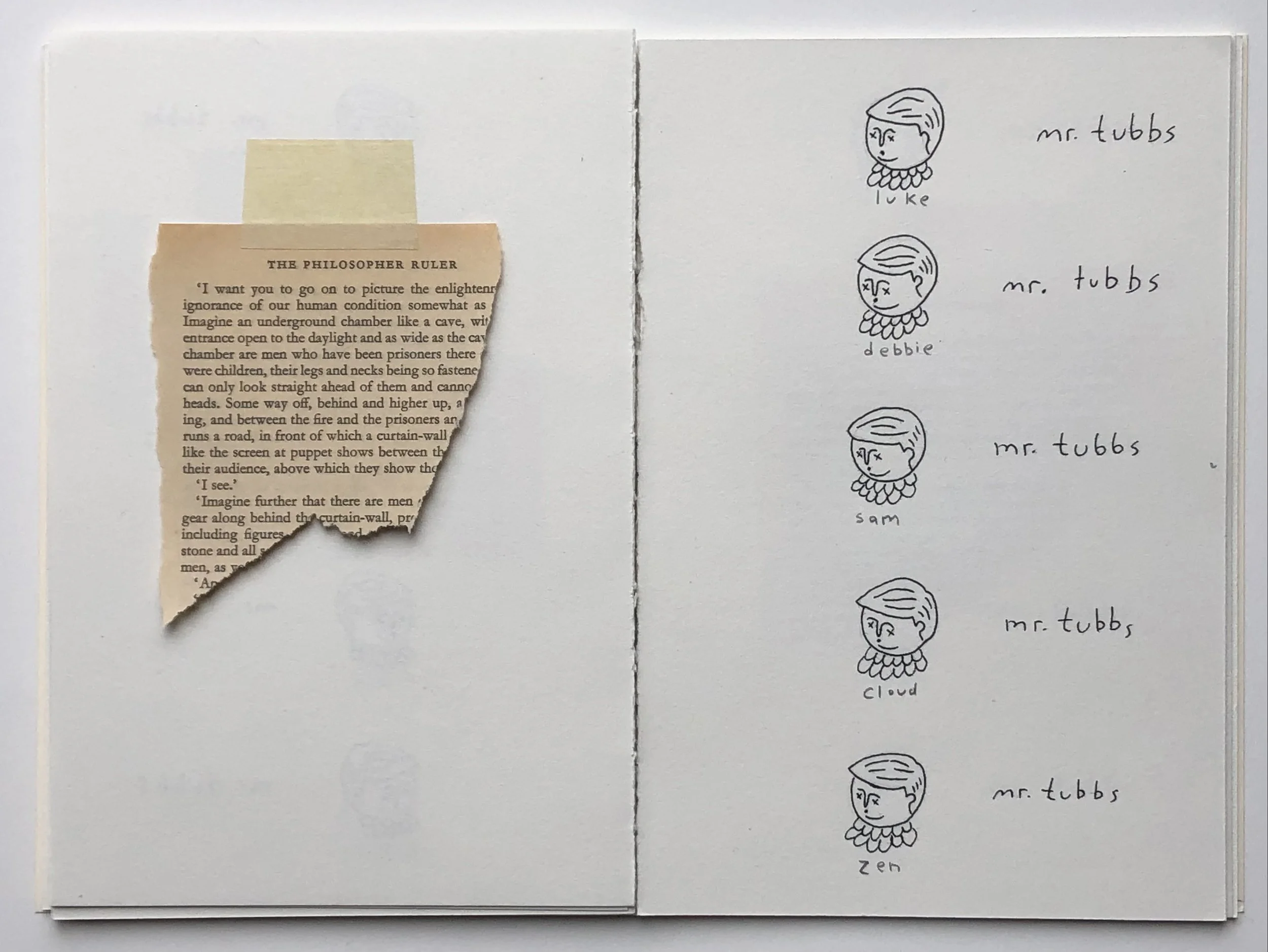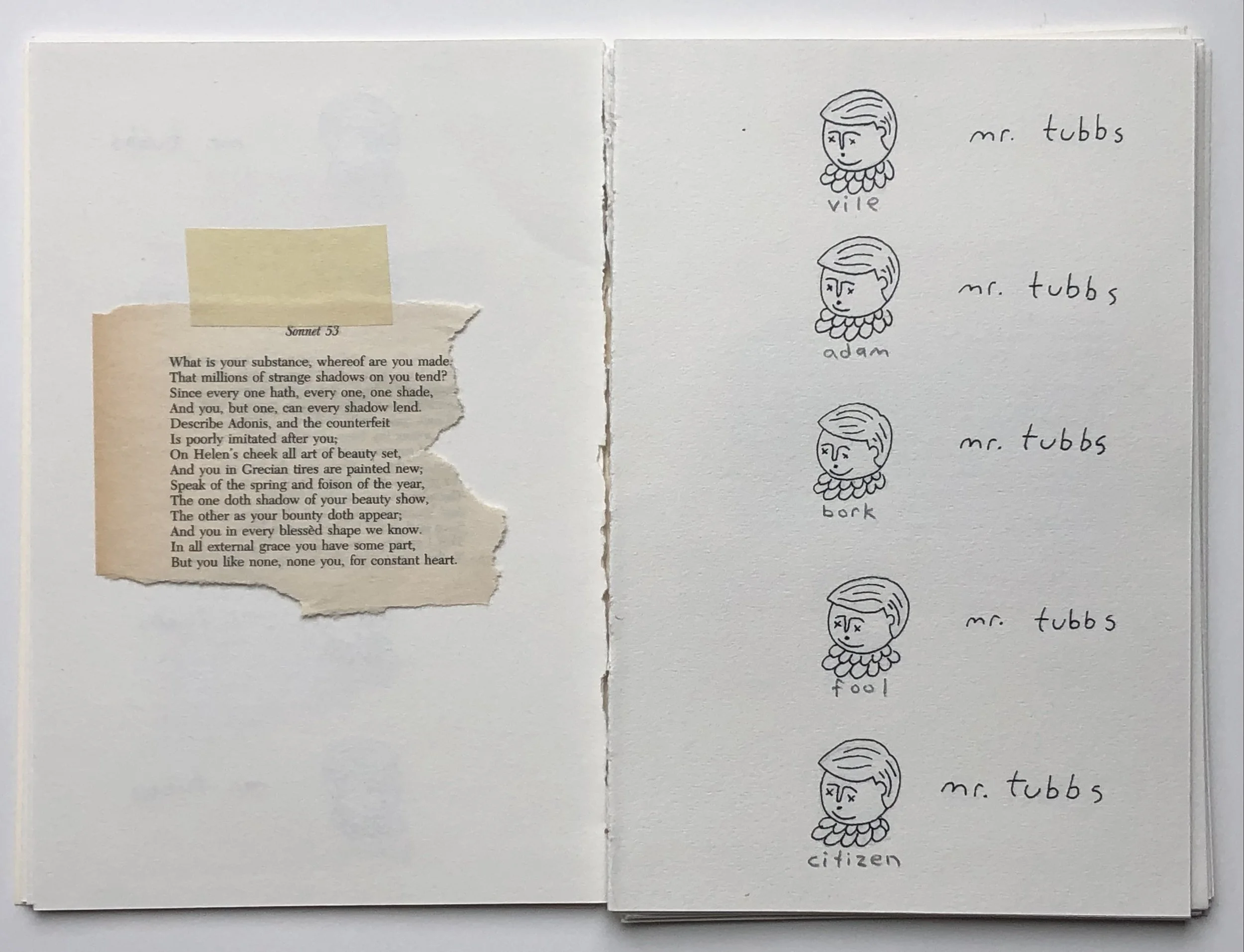135 Portraits of Mr. Tubbs







ABOUT THE WORK
Excerpts from an interview for You’re Dumb, I’m Not Dumb Magazine, March 7, 2023.
Your Work 135 Portraits of Mr. Tubbs contains 135 drawings of a character named Mr. Tubbs, what were you trying to accomplish?
In our consumer culture the image of one’s self is so closely aligned to the essence of one’s self. Thus, the proliferation of our image, is in many ways a proliferation of our self. Our image multiplies and becomes scattered, dispersed across various social media platforms, inside numerous privatized databases, as well as government surveillance databases. One’s image is captured on every single camera we encounter. Raw images, but also deliberate images, our image on instagram, curated, posed, filtered, is vastly different from the image on one’s driver’s license. As image goes, so goes the self that is infused within the image. Our image-as-self is turned into data, it is manipulated, bought, sold, altered by powers beyond our control to such an extent that I think we can legitimately ask Am I even my self? Do I own my self?
That’s interesting. Your work also includes many excerpts from various works of literature and philosophy. What works did you take excerpts from, and why are they included?
All the works I used for the book deal with issues and explorations of reproduction, replication, and representation of image and self. Excerpts from Shakespear’s Sonnets, as well as his plays Hamlet and Twelfth Night are used; a Dostoevsky novel The Double; a chapter from Gilles Deleuze and Felix Guattari’s A Thousand Plateaus, Mary Shelley’s Frankenstein, some erotica from Penthouse Letters, the Federalist Papers and parts of the Constitution, Plato’s Allegory of the Cave. As I mentioned, all of these deal with the issue of reproduction, replication, and representation of image and self.
Let’s begin with Shakespeae, why select writings from the Bard?
In his Shakespeare: the Invention of the Human literary critic Harold Blume essentially argues that Shakespeare’s plays re-established what it means to be human. Shakespeare scripted the modern human psychological self. Shakespear’s Sonnets deal deeply with the conjunction of desire and narcissism, a fascination of one’s own image. His sonnets were the the first modern poetic expression of the absolute tangle of ego, narcissism, and desire, which this desire for self extends all the way to modern pornography, which is why some contemporary erotica is included in the work.
Why Hamlet and Twelfth Night?
In Plato’s work the Symposium, Socrates discuses one way for us to achieve immortality of self is genetically, through the production of offspring. Out of all the other themes the play Hamlet explores, the representation of a genealogical self is investigated. A self existing over multiple generations. Hamlet’s revenge of his father is an act of self valorization. The father’s ghost achieves his vengeance through the son, the son becomes one with the father. Very much the same with Twelfth Night, but horizontally with siblings, rather than vertically with parent and child. Viola dressing up as a perfect representation of her brother allows her to become her brother, to bring her brother back from the dead and to merge into him. A unity of one in two.
Turning to Plato, you include excerpts from his Allegory of the Cave, why?
Allegory of the Cave is a labyrinth of representation, copies and copies of copies are presented. In a very real sense it’s copies all the way down. Of course, this denies the very concept of authenticity, which is very intriguing. A cloud of self composed of copies.
Circling back to Hamlet, and I’m coming at this because of Plato’s political writings, and his distrust of Democracy…
His idea that tyranny naturally rises out of democracy?
Yes. I’m thinking about politics in Hamlet. Monarchy as another sort of representation?
Certainly, I think the relationship of the Monarch to his Subjects, is one of representation. A murder of a subject by another subject is a trespass against the Monarch. The victim, at least one part of him, is a tiny representation of the Monarch, and the killing of the Monarch is forbidden, thus the Subject’s murder is forbidden. Which, this notion of subjects being representations of leaders is echoed in our modern representative democracy, which is why I included excerpts from the Federalist Papers and Constitution.
But, wouldn’t it be the opposite of a subject being a representation of the Monarch? In today’s representative democracies, the Leaders are representations of the citizens.
I think you’re correct in one sense, and this is how the representational model, rather than swapping who is represented, rather it complexities the situation. Because, yes, we elect a representative as our voice, as ourself, in government, but in that election, we combine with others who are represented by the same politician. The representative becomes a representation of hundreds of thousands of people. Hundreds of thousands of people become reproduced inside the politician, and in doing so our self, our wants, fears, hopes, all of it becomes essentially neutered inside the politician. The self disappears into the politician. The self disappears into the representation.
You include excerpts from Deleuze and Guattari’s A Thousand Plateaus, why are they included?
The excerpts come from the “chapter” titled Year Zero: Faciality, in which the two postulate that the face isn’t “natural.” When I discussed one’s image earlier I was alluding to the image of one’s Face. Why? Why is the Face considered our image? Why is the Face associated so deeply with the Self?
What do you mean the face isn’t natural?
Deleuze and Guattari argue that the Face is a semiotic social construction that emerges out of very particle power dynamics. For example, do you know what your lover’s left elbow looks like? Or the back of their right knee? Or the bottom of their left big toe? Those body parts are non-descript, merely part of the background. It is the Face that has been pulled out of the background, and developed as Signifier, as a sign of one’s self. And it is usually the face that is reproduced as a marker of self. Reproduced, as I mentioned earlier, endlessly. And like a child who says a word over and over again until it loses its meaning, its signification, its importance, the face, as a “word", as a signifier of self, losses it meaning, its importance in its endless reproduction. As does the self.
